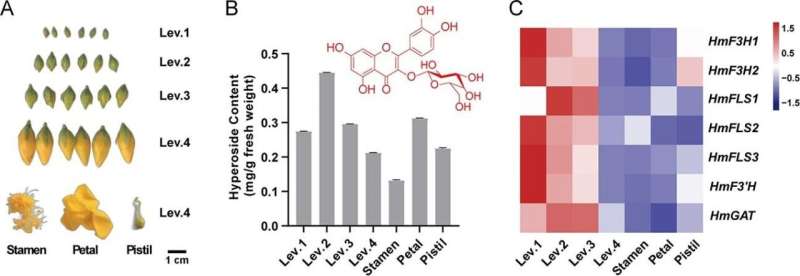Unveiling biosynthesis of hyperoside: A pathway to sustainable production in Hypericum monogynum

Hyperoside, a beneficial flavonoid galactoside found in both medicinal and edible plants, plays a critical role in plant growth, self-defense, and breeding, as well as in human health through its numerous pharmacological properties. However, the biosynthetic pathway of hyperoside in plants, including its original source, Hypericaceae, has not been systematically elucidated yet.
In August 2023, Horticulture Research published titled "The parallel biosynthesis routes of hyperoside from naringenin in Hypericum monogynum."
In this study, researchers explored the biosynthetic mechanism of hyperoside in Hypericum monogynum by sequencing its flower buds' transcriptome. They identified four key enzymes involved in hyperoside production: HmF3Hs, HmFLSs, HmF3'H, and HmGAT, each playing a distinct role in converting flavanones and dihydroflavonols into flavonols and their galactosides, with hyperoside being the end product.
The investigation revealed that these enzymes have broad substrate selectivity, suggesting multiple biosynthesis pathways for hyperoside. HmF3'H (flavonoid 3'-hydroxylase) acts extensively on 4'-hydroxyl flavonoids to produce 3',4'-dihydroxylated flavonones, dihydroflavonols, flavonols, and flavonoids, and HmGAT (flavonoid 3-O-galactosyltransferase) converts flavonols to the corresponding 3-O-galactosides including hyperoside.
The study further delved into the functional characterization of these enzymes through in vivo and in vitro assays, revealing their substrate specificities and catalytic activities. Notably, the research successfully reconstructed a hyperoside biosynthesis pathway in Escherichia coli BL21(DE3), achieving a yield of 25 mg/l by feeding naringenin.
This pathway reconstruction, along with optimization of feeding conditions and cofactor use, provides insights into the parallel biosynthesis routes of hyperoside in H. monogynum and demonstrates a novel approach for hyperoside production in heterologous systems.
Additionally, molecular docking and site-directed mutagenesis experiments elucidated the functional diversity and activity discrepancy among the enzymes, offering a deeper understanding of their catalytic mechanisms.
In summary, this study not only advances our knowledge of the biosynthesis of hyperoside and its regulation, but also offers the possibility of efficient production of this valuable flavonoid through biotechnological means.
More information: Yingying Wang et al, The parallel biosynthesis routes of hyperoside from naringenin in Hypericum monogynum, Horticulture Research (2023).
Provided by TranSpread



















